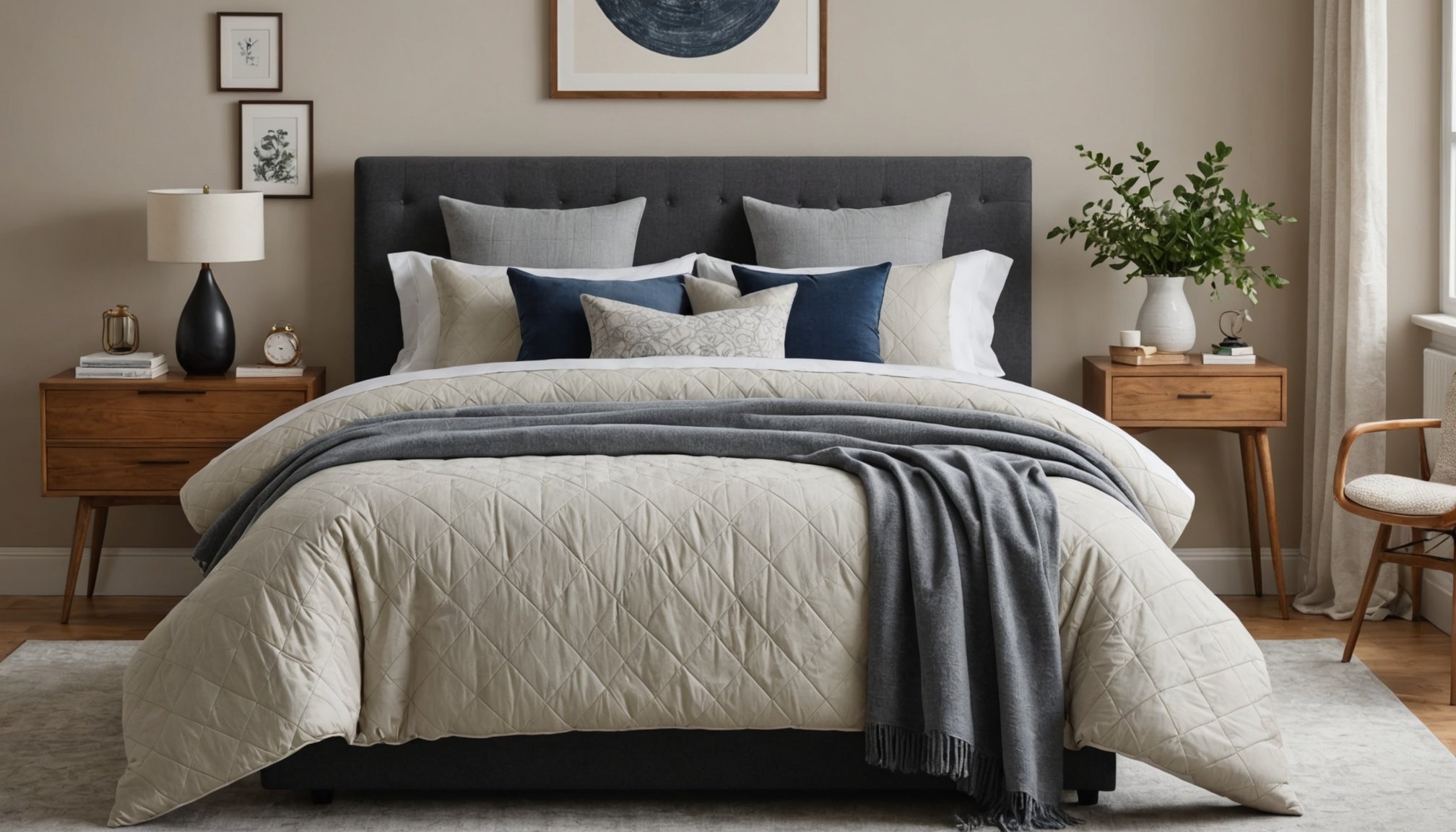Creating a healthy bedroom environment is essential for better sleep and overall well-being. Hypoallergenic fabrics play a vital role in reducing allergens and irritants that affect sensitive individuals. In this guide, discover the top hypoallergenic materials for your bedding, curtains, and upholstery. Learn how simple choices can enhance your living space, providing comfort and peace of mind while promoting a restful night's sleep in your UK home. Transform your bedroom into a sanctuary with these expert recommendations.
Overview of Hypoallergenic Fabrics
Hypoallergenic fabrics are specially designed to minimize allergic reactions by reducing the presence of allergens. These materials are crafted to be less likely to cause an allergic response, making them a crucial element in maintaining a healthy bedroom environment. They act as a barrier against common allergens such as dust mites, pet dander, and pollen, which often reside in non-hypoallergenic fabrics.
A lire en complément : Blending Past and Present: Creative Ways to Infuse Tudor Architecture into Contemporary UK Home Decor
Definition and Characteristics
Hypoallergenic fabrics are typically made from tightly woven materials or treated with specific chemicals to prevent allergens from penetrating the fabric. Natural fibers like cotton, silk, and bamboo are often used due to their breathability and softness, which enhance comfort while reducing irritation.
Importance for Bedroom Health
Incorporating hypoallergenic fabrics in your bedroom can significantly improve air quality and reduce allergy symptoms. Bedding, curtains, and upholstery made from these materials help create a sanctuary free from irritants, promoting better sleep and overall well-being.
A lire également : Transform your living space with luxury home interior design
Common Allergens in Non-Hypoallergenic Fabrics
Non-hypoallergenic fabrics can harbor allergens, leading to increased exposure and potential health issues. Dust mites thrive in warm, humid environments, while pet dander and pollen easily cling to fibers. Choosing hypoallergenic options helps mitigate these risks, providing a cleaner, safer space.
Types of Hypoallergenic Fabrics
Exploring the types of hypoallergenic fabrics available can help you make informed choices for a healthier living space. These fabrics are crafted to reduce allergens and improve comfort.
Natural Fabrics
Natural fabric materials are popular in the UK for their gentle properties. Cotton is soft, breathable, and widely used in bedding and clothing. Linen offers durability and a natural ability to wick moisture, making it ideal for warm climates. Silk is luxurious and smooth, providing a gentle touch for sensitive skin.
Synthetic Fabrics
Synthetic options provide additional benefits. Microfiber is tightly woven, creating a barrier against allergens. Polyester is durable and easy to maintain, often used in allergy-friendly bedding. Bamboo fabric, though technically a regenerated cellulose fiber, is praised for its softness and eco-friendliness, offering a sustainable choice.
Comparison of Fabric Types
- Breathability and moisture-wicking: Natural fabrics like cotton and linen excel in breathability, while microfiber and bamboo offer moisture-wicking properties.
- Durability and maintenance: Polyester and linen are known for their durability, requiring minimal upkeep.
- Allergic reactions and sensitivities: Silk and bamboo are gentle on sensitive skin, reducing the risk of irritation.
Benefits of Using Hypoallergenic Fabrics in Bedrooms
Incorporating hypoallergenic fabrics into your bedroom provides numerous health benefits and enhances overall comfort. These specially designed materials play a crucial role in reducing allergy symptoms and respiratory issues. By acting as a barrier against allergens like dust mites and pet dander, they help minimize exposure and alleviate common allergic reactions.
A significant advantage of hypoallergenic fabrics is their contribution to enhanced comfort and sleep quality. Natural fibers such as cotton and silk offer a soft and breathable texture, promoting a more restful sleep environment. The gentle nature of these materials reduces skin irritation and ensures a soothing touch, particularly beneficial for individuals with sensitive skin.
Moreover, these fabrics offer easy maintenance and cleaning advantages. Many hypoallergenic materials are designed to withstand frequent washing without losing their protective properties. This feature not only ensures a cleaner sleeping space but also simplifies the upkeep of bedding and upholstery. Regular washing helps maintain the fabric's integrity, ensuring long-lasting protection against allergens.
In summary, the benefits of hypoallergenic fabrics in bedrooms extend beyond allergen reduction. They provide a comfortable, easy-to-maintain environment that supports better health and improved sleep quality.
Practical Tips for Choosing and Using Hypoallergenic Fabrics
When choosing hypoallergenic fabrics, it's crucial to consider factors such as material type, weave, and ease of maintenance. Opt for tightly woven fabrics like microfiber or natural options like cotton and silk, which are less likely to trap allergens. Consider the breathability and comfort of the fabric to ensure a restful sleep environment.
In the UK, several retailers offer a range of hypoallergenic fabrics. High street stores such as John Lewis and Debenhams provide quality options, while online platforms like Amazon and Wayfair offer a wide selection with customer reviews to guide your purchase. These retailers often feature detailed product descriptions, helping you make informed decisions.
Integrating hypoallergenic fabrics into your bedroom decor can be both functional and stylish. Start with bedding, as it directly impacts your sleep quality. Choose duvet covers, sheets, and pillowcases made from hypoallergenic materials. For curtains and upholstery, select designs that complement your existing decor while providing allergen protection. Consider using hypoallergenic mattress covers and pillow protectors to further reduce allergen exposure. By thoughtfully selecting and incorporating these fabrics, you can create a comfortable, allergy-friendly space that enhances your well-being.
Maintenance and Care for Hypoallergenic Fabrics
Proper fabric maintenance is essential to ensure the longevity and effectiveness of hypoallergenic fabrics. Regular care helps maintain their protective qualities, keeping allergens at bay.
Best Practices for Washing
When washing hypoallergenic fabrics, use gentle cycles and cold water to prevent damage. Avoid using harsh detergents that may irritate sensitive skin. Instead, opt for mild, fragrance-free cleaning products specifically designed for delicate textiles. This approach not only preserves the fabric's integrity but also enhances its allergen-reducing properties.
Recommended Cleaning Products and Methods
For optimal results, choose cleaning products that are hypoallergenic and free from dyes and perfumes. Consider using a mild detergent with natural ingredients to minimize skin irritation. For tough stains, a solution of vinegar and water can be effective without compromising the fabric's quality. Always follow the care label instructions to avoid any mishaps.
Prolonging Fabric Longevity
To extend the life of hypoallergenic textiles, avoid overloading the washing machine. This prevents excessive friction and wear. Dry fabrics on a low heat setting or air dry to maintain their structure and softness. By following these cleaning tips, you can ensure your hypoallergenic fabrics remain effective and long-lasting.











